- 1The Key Laboratory for Silviculture and Conservation of Ministry of Education, Beijing Forestry University, Beijing, China
- 2State Key Laboratory of Mycology, Institute of Microbiology, Chinese Academy of Sciences, Beijing, China
- 3College of Education, Ibaraki University, Ibaraki, Japan
- 4Museum of Beijing Forestry University, Beijing Forestry University, Beijing, China
Hamamelidaceae is composed of woody plant taxa of important economic value; however, reports on diseases affecting these plants are rare. Three kinds of rusts were studied, of which the first one is characterized by catenulate spores in peridiate columnar sori on Sycopsis sinensis, the second one produces two-celled pedicellate teliospores in pulvinate sori on S. sinensis and Corylopsis spp., and the last one produces aeciospores in cup-shaped aecia on Hamamelis spp. Phylogenetic analyses indicated that the three species belong to the same genus in Pucciniaceae. The first fungus is distinct in teliospore morphology, producing one-celled catenulate spores in peridiate columnar sori and molecular phylogeny from species of other genera. Thus, it is described herein as a new genus and species Novopuccinia sycopsis-sinensis in Pucciniaceae. The latter two species were reported as Puccinia corylopsidis and Aecidium hamamelidis, respectively. However, phylogenetic analysis using ITS and 28S genes has revealed that these are closely related to the new genus and species. By combining host, distribution, and evolutionary hypothesis of rust fungi with endocyclic life cycle, these are reclassified as N. corylopsidis and N. hamamelidis. Taxonomic descriptions, illustrations, and a key to rust fungal species occurring in Hamamelidaceae in Asia are provided.
Introduction
Several Hamamelidaceae plant species are of significant ecological value in the subtropical humid evergreen broad-leaved forest community (Xu, 2001). Some species such as Sycopsis sinensis also have special habitat requirements and therefore show scattered distribution in the whole range of the subtropical humid evergreen broad-leaved forests. S. sinensis has been listed as a class of protected species in several provinces (Zang and Bian, 2003; Xu et al., 2007).
Four rust fungi are known to infect trees of Hamamelidaceae in Asia. Aecidium hamamelidis Dietel (synonym: Puccinia mitriformis S. Ito on Sasa) parasitizes Hamamelis (Hiratsuka and Sato, 1970; Hiratsuka et al., 1992; Ono, 2017). P. sasicola (Hara) Hino & Katum is heteroecious but demicyclic, host-alternating between Corylopsis (spermogonial/aecial stages) and Sasamorpha (uredinial/telial stages) (Hara, 1939, 1952). P. corylopsidis Cummins with two different types of teliospores is microcyclic on Corylopsis, and P. sakamotoi Hirats. f. & Yoshino with columnar telia is demicyclic and autoecious on Distylium (Hiratsuka, 1942).
Rust fungi, Pucciniales, are obligate plant parasites and comprise one of the largest groups in Basidiomycota. Approximately one half of the nearly 8,000 described rust species belong to the genus Puccinia Pers., which is mainly characterized by two-celled teliospores (Index Fungorum)1. Several molecular phylogenetic studies have shown that Puccinia spp. is a polyphyletic group and some species are misclassified under this genus name (Aime, 2006; Minnis et al., 2012; Beenken and Wood, 2015). These recent studies have revealed that the taxonomy of the species within the huge genus Puccinia is worth exploring.
In this study, three distinct symptoms with different sporulation of rust fungi were observed on Hamamelidaceae trees. Of these, two fungi produce telia; i.e., one produces two-celled pedicellate spores in pulvinate sori on S. sinensis and Corylopsis sp., while another generates one-celled catenulate spores in peridiate columnar sori on S. sinensis. Long intercalary cells are prominent in this fungus. The other produces spermogonia and cup-shaped aecia on Hamamelis spp. This study aimed to determine the taxonomic status and relationship of three Hamamelidaceae fungi by morphological, molecular phylogenetic, host, and evolutionary analyses of these endocyclic rust fungi. A new genus, Novopuccinia, and three species, namely, N. sycopsis-sinensis sp. nov., N. corylopsidis comb. nov., and N. hamamelidis comb. nov., are described and presented here in detail. All of the rust species of Hamamelidaceae are listed, and their hosts and distribution are provided.
Materials and Methods
Study Site and Specimens
Four rust specimens were collected from diseased S. sinensis on Mt. Sanqingshan, northeast Jiangxi Province, China (Figure 1), in 2017. Rust specimens on Hamamelis sp. were collected from Ibaraki, Japan, by Y. Ono (IBAR). The host tree was identified by referring to the Flora of China2. These specimens were deposited at the Museum of the Beijing Forestry University (BJFC), Beijing, China. Individual specimens are listed under each species in the Taxonomy section. Photomicrographs of type specimens of P. corylopsidis were provided by the U. S. National Fungus Collections (BPI).
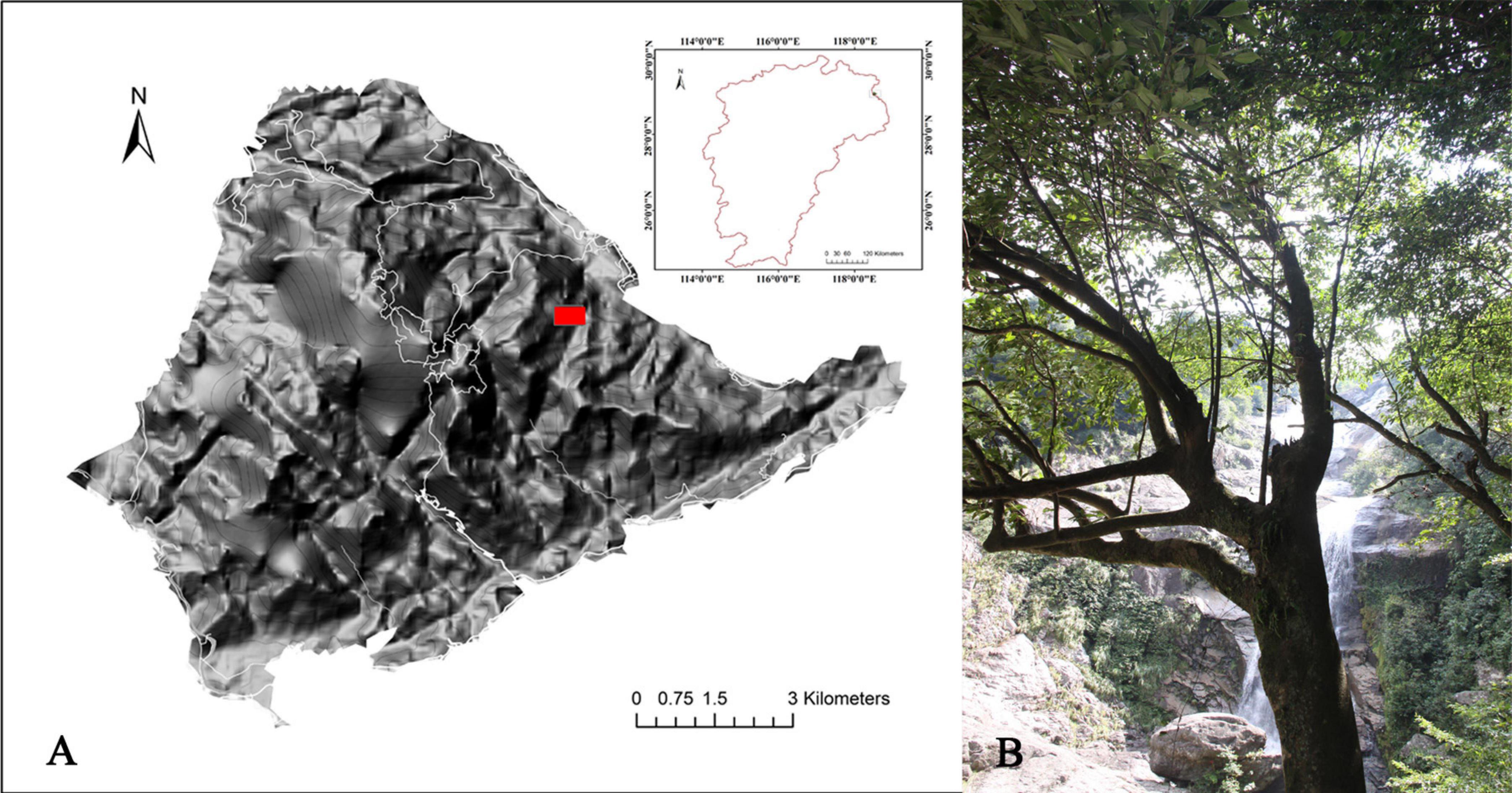
Figure 1. (A) Type species location of Novopuccinia on Mt. Sanqingshan of Jiangxi Province, China. (B) The indigenous host, Sycopsis sinensis, occurring to the mountain.
Morphology
Rust sori from fresh collections were free-hand sectioned using a double-edged blade under a binocular microscope. Spores were scraped from sori on the dried specimens. Thin sections and spores were mounted in a drop of lactophenol solution on a microscope slide and observed, measured, and photographed using a Leica DM3000 upright microscope (Leica, Germany). For scanning electron microscopy (SEM), fragments of dried leaves with sori and spores were mounted on SEM stubs with double-sided tape. The samples were coated with gold using a Hitachi SCD-005 sputter coater and examined with a Hitachi S-3400 scanning electron microscope (Hitachi, Tokyo, Japan) operated at 5 kV.
DNA Extraction and PCR Amplification
Genomic DNA was extracted from the sori by a method described by Tian et al. (2004). The primer pairs NL1 and NL4 for nuc rDNA 28S (28S) (O’Donnell, 1993) and Rust2inv and ITS4rust for Nuc rDNA internal transcribed spacer region (5.8S-ITS2) (Aime, 2006; Beenken et al., 2012) were used in this study. The PCR conditions were fully described by Liu et al. (2018). The PCR amplification products were estimated visually by electrophoresis in 1.5% agarose gels. DNA sequencing was performed using an ABI PRISM® 3730xl DNA Analyzer with BigDye® Terminater Kit v. 3.1 (Invitrogen) at the Shanghai Invitrogen Biological Technology Company Limited (Beijing, China).
Phylogenetic Analyses
The sequences of the 28S and 5.8S-ITS2 genes from this study and reference sequences obtained from GenBank (Supplementary Table 1) were aligned and edited manually using online MAFFT3 (Katoh and Standley, 2013). The alignments were concatenated for phylogenetic analyses. The alignments were concatenated for phylogenetic analyses. Maximum parsimony (MP) analyses were conducted with PAUP v. 4.0b10 (Swofford, 2003), using 1,000 heuristic search replicates with random additions of sequences with the tree bisection and reconnection (TBR) branch swapping algorithm. All molecular characters were unordered and given equal weight; analyses were performed with gaps treated as missing data. All equally parsimonious trees found were saved in the MP analyses. Other calculated parsimony scores were tree length (TL), consistency index (CI), retention index (RI), and rescaled consistency (RC). MP bootstrap analyses with 1,000 replicates were performed in the same way, with 10 rounds of replicates of heuristic search with random addition of sequences and subsequent TBR branch swapping during each bootstrap replicate. ML analysis was performed with a GTR + I + G substitution model selected by MrModeltest v.2.3 (Posada and Crandall, 1998). Branch support was evaluated with a bootstrapping (BS) method with 1,000 replicates. For Bayesian Inference (BI), the best-fit model of substitution among those implementable in MrBayes was estimated separately for each gene using jModeltest (Darriba et al., 2012) on the CIPRES portal, based on the Bayesian Information Criterion (BIC). According to the results of MrModeltest, Bayesian Inference (BI) of the 28S was performed using MrBayes 3.1.2 (Ronquist and Huelsenbeck, 2003), implementing the GTR + I + G model. BI was performed by a Markov chain Monte Carlo (MCMC) algorithm (Rannala and Yang, 1996). The MCMC chains were run for 1 million generations and saved every 1,000 generations. Sequence alignments were deposited at TreeBASE4 under the accession number 27,477.
Results
To confirm the phylogenetic placement of the fungi in Hamamelidaceae and their relationship, a phylogenetic tree was established based on 28S (Figure 2). The phylogenetic results were mostly congruent with recent studies of rust fungi (Aime and Mctaggart, 2020). However, the support value was lower because only the 28S gene was used in the analysis. In this tree, the new genus was clustered with the Pucciniaceae, which was represented by 14 genera and separated from every genus. In addition, the 28S and 5.8S-ITS2 genes of 46 rust taxa from 13 genera of Pucciniaceae were analyzed, using Dasyspora guianensis as outgroup taxa (Figure 3). The MP analyses of the combined 28S and ITS contained 899 characters. Of these, 537 characters were constant, 105 variable characters were parsimony uninformative, and 257 were parsimony informative. There were 11 equally most parsimonious trees, with the first tree (TL = 1,183, CI = 0.496, RI = 0.630, RC = 0.314). The phylogenetic trees obtained from ML and BI analyses with the MCMC algorithm coincided with the MP tree shown in Figure 3. The rust fungi on Hamamelidaceae form three separate clades on one big branch and represent three different species, namely, Novopuccinia corylopsidis, N. hamamelidis, and N. sycopsis-sinensis (Figure 3). The type species of Puccina, namely, P. graminis, was placed within the Puccinia/Uromyces subclade. Novopuccinia was distantly related to the clade represented by type species P. graminis and closely related to Stereostratum, with lower support value (Figure 3).
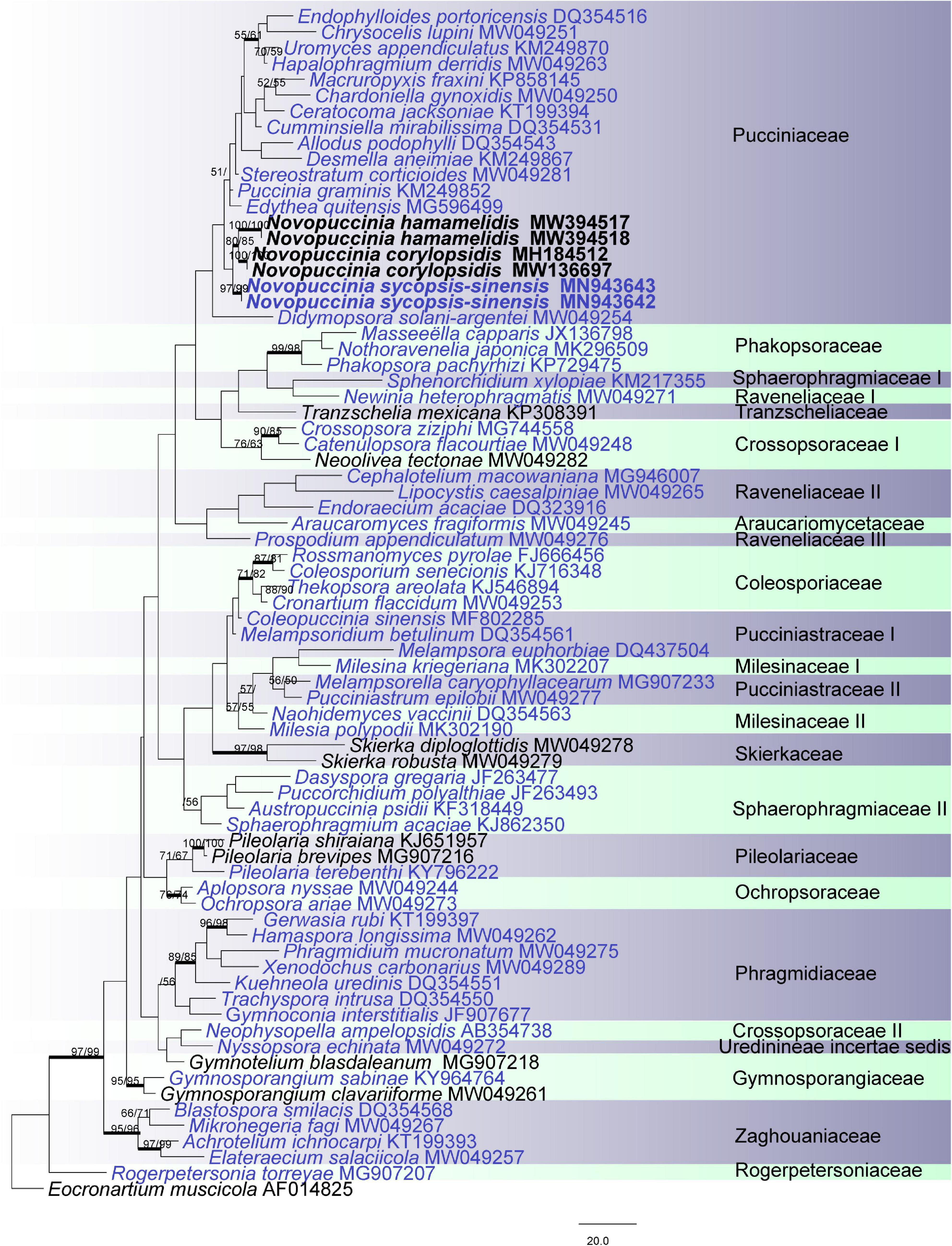
Figure 2. Pucciniales. Phylogram obtained from maximum parsimony, maximum likelihood, and Bayesian analysis of 28S. The tree is rooted with Eocronartium muscicola. Genera represented by types are blue; numbers above branches indicate bootstrapping support (1,000 replicates) for each node as MP/ML. Thickened branches indicate PP > 0.95 from the Bayesian inferences. Bars: 20.0 nucleotide substitutions. The new genus proposed is in boldface.
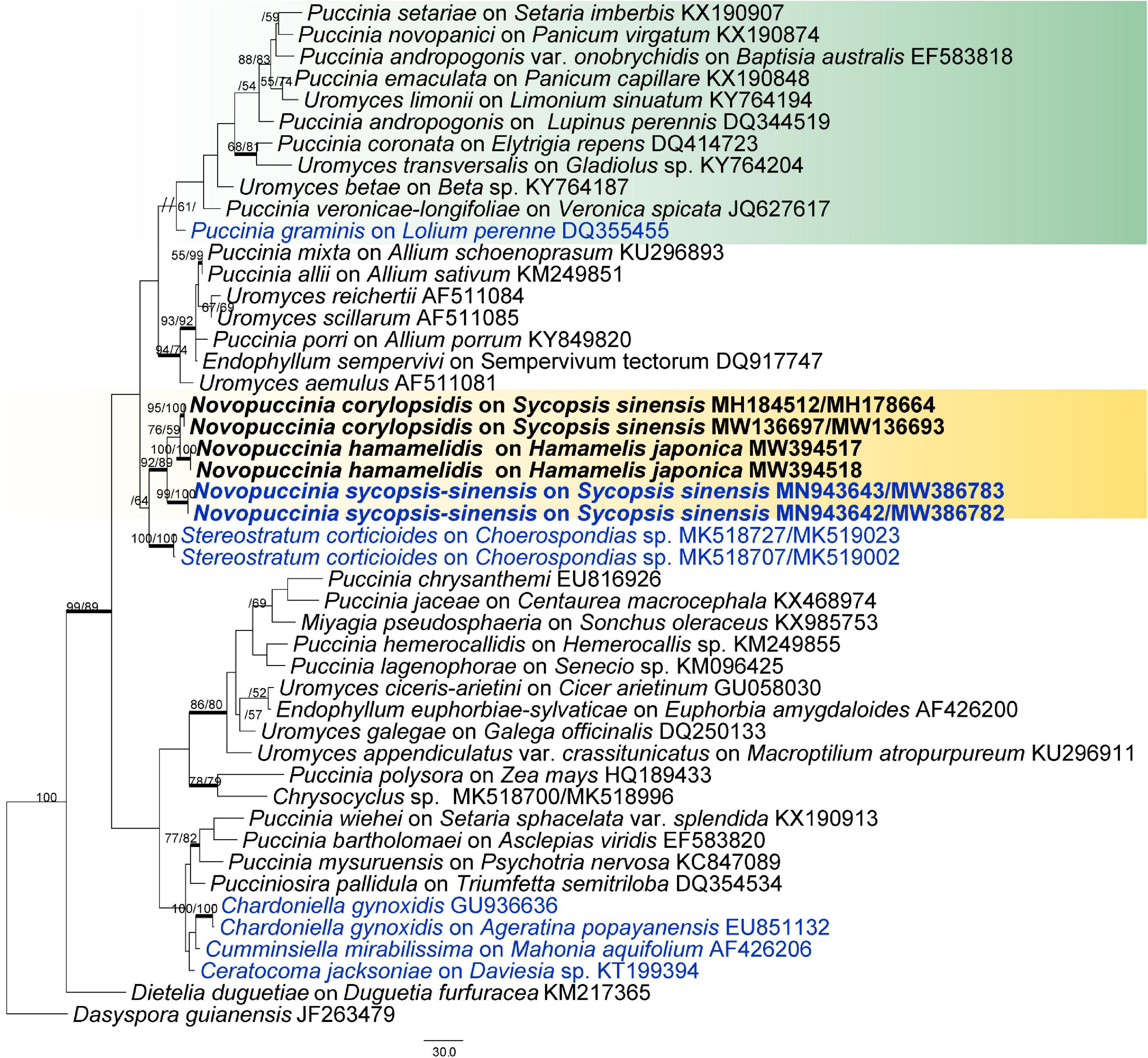
Figure 3. Phylogenetic tree in Pucciniaceae based on maximum parsimony, maximum likelihood, and Bayesian analysis of the ITS and 28S sequences. Dasyspora guianensis was used as outgroup. Genera represented by types are blue; numbers above branches indicate bootstrapping support (1,000 replicates) for each node as MP/ML. Thickened branches indicate PP > 0.95 from the Bayesian inferences. Bars: 30.0 nucleotide substitutions. The new genus proposed is in boldface.
Taxonomy
Novopuccinia Y. M. Liang & Y. Liu, gen. nov.
MycoBank MB838356
Type species: Novopuccinia sycopsis-sinensis Y. M. Liang & Y. Liu, sp. nov.
Etymology: Novopuccinia (Lat.) referring to the new type taxon in Puccinia-complex.
Descriptions: Spermogonia subepidermal and mostly globose. Aecia subepidermal in origin, cupulate with well-developed peridium (Aecidium-type). Uredinia subepidermal in origin and becoming erumpent (Uredo-type). Telia subepidermal in origin, becoming erumpent, either pulvinate or columnar; teliospores one-celled and catenulate with a long intercalary cell or two-celled and pedicellate.
Habitat and distribution: Currently only known on Hamamelidaceae in Asia.
Notes: Morphologically, the telia/teliospores of Novopuccinia consist of two types. One is represented by N. sycopsis-sinensis, which produces one-celled, catenulate teliospores in columnar telia. It is taxonomically distinct from other morphologically similar genera in Pucciniaceae, i.e., Ceratocoma, Chardoniella, Dietelia, and Trichopsora. Novopuccinia (Figure 4), Chardoniella, and Trichopsora produce hair-like telial columns and long, pedicel-like intercalary cells between individual teliospores (Lagerheim, 1891; Kern, 1939). In contrast, Ceratocoma and Dietelia have small, often inconspicuous, intercalary cells (Buriticá and Hennen, 1980; Buriticá, 1991; Cummins and Hiratsuka, 2003). The presence of a well-developed peridium in the telia is also a distinct characteristic of Novopuccinia, separating it from Ceratocoma, Chardoniella, and Trichopsora, which produce non-peridiate telia (Cummins and Hiratsuka, 2003; Berndt, 2018). A metabasidium replaces a probasidium without substantial morphological change in Trichopsora, while Ceratocoma, Chardoniella, and Novopuccinia produce a metabasidium external to a probasidium. In addition to these morphological distinctions, N. sycopsis-sinensis with one-celled teliospores is clearly separated from Ceratocoma, Chardoniella, and Dietelia in the molecular phylogenetic tree (Figures 2, 3: molecular data of Trichopsora for the analysis was lacking).
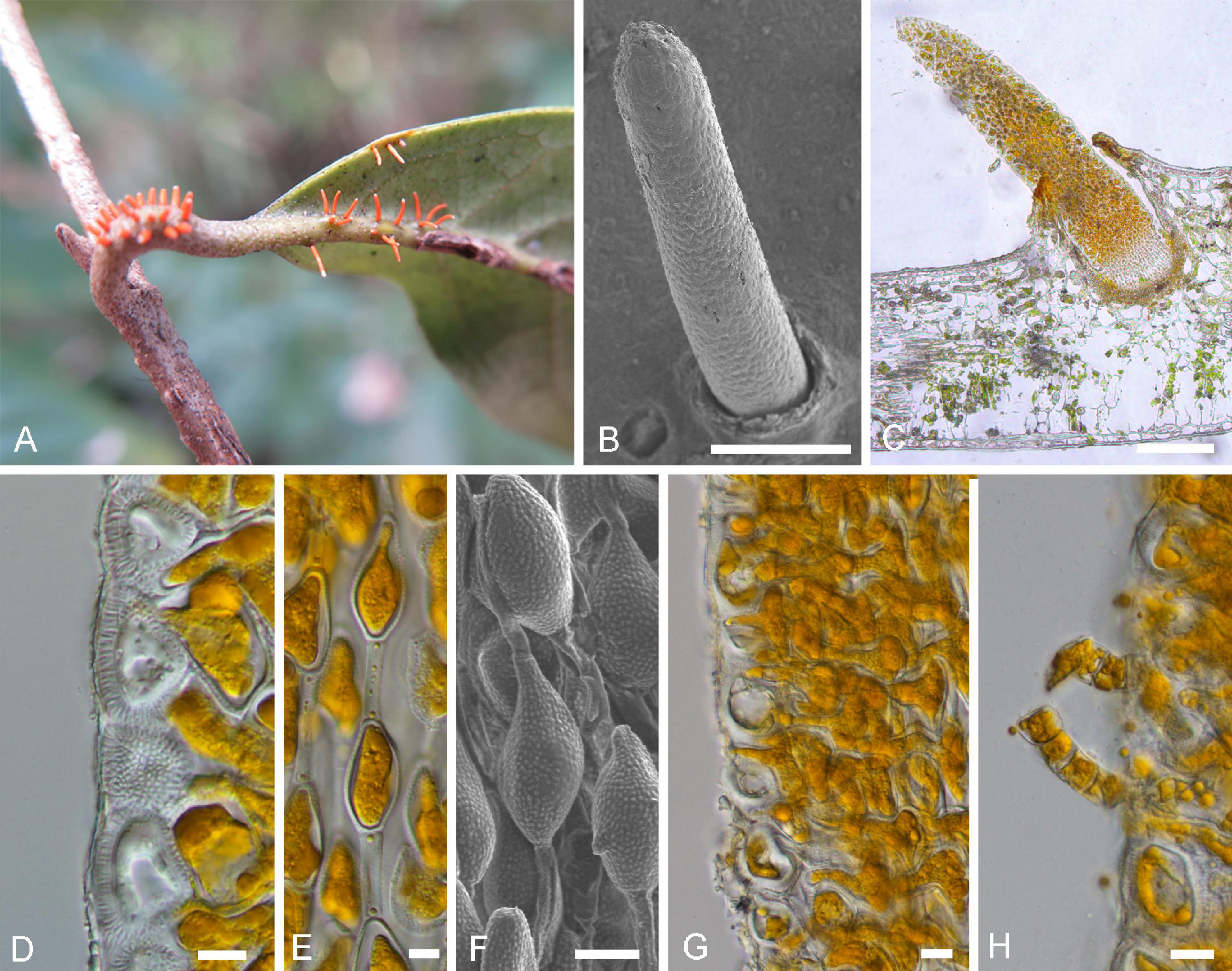
Figure 4. Morphology of Novopuccinia sycopsis-sinensis (BJFC-R02976, holotype). (A) Sori on a leaf and branches. (B) A teliospore, as seen by SEM. (C) Longitudinal section of a teliospore, as seen by LM. (D) Peridium cells, as seen by LM. (E) Teliospores, as seen by LM. (F) Teliospores, as seen by SEM. (G,H) Basidia as seen by LM. Scale bars: (B,C) = 1 mm; (D,H) = 10 μm.
Another telium/teliospore type is similar to those of Puccinia in two-celled with pedicellate (Figure 4), but it can be distinguished from almost all other species by thick-walled teliospores and Hamamelidaceae host. Our phylogenetic results also supported the independence of this type of rust on Hamamelidaceae from the large genus Puccinia (Figures 2, 3).
Novopuccinia sycopsis-sinensis Y. Liu & Y. M. Liang, sp. nov. Figure 4
MycoBank MB 838357
Typification: CHINA. Mt. Sanqingshan, Jiangxi Province, 28°53′88″N, 118°04′57″E, 1,340 m alt., April 1, 2017, on Sycopsis sinensis Oliv, coll. Y.M. Liang (Holotype: BJFC-R02976; Paratype: BJFC-R02983).
Etymology: Named after the host name of the type species.
Descriptions: Spermogonia, aecia, and uredinia unknown. Telia hypophyllous or petiolicolous, orange, hairlike columnar, exposed, and 2–5 mm long. Teliospores one-celled with elongated pedicel-like intercalary cells (25 μm long), ellipsoid to obovoid, 20–35 × 9–14 μm, and attenuate toward both ends; cytoplasm yellow; the wall colorless, 0.5–1 μm thick, and densely verrucose. Peridium cells rectangular to rounded, 20–31 × 18–23 μm; the wall colorless, 3–5 μm thick, and rough-surfaced.
Notes: N. sycopsis-sinensis can be easily distinguished from other similar taxa by elongated pedicel-like intercalary cells, one-celled, and peridium cells (Figure 4). According to Tranzschel’s law, the species has an endocyclic life cycle (Buriticá and Hennen, 1980; Buriticá, 1991).
Novopuccinia corylopsidis (Cummins) Y. Liu & Y. M. Liang, comb. nov. Figure 5
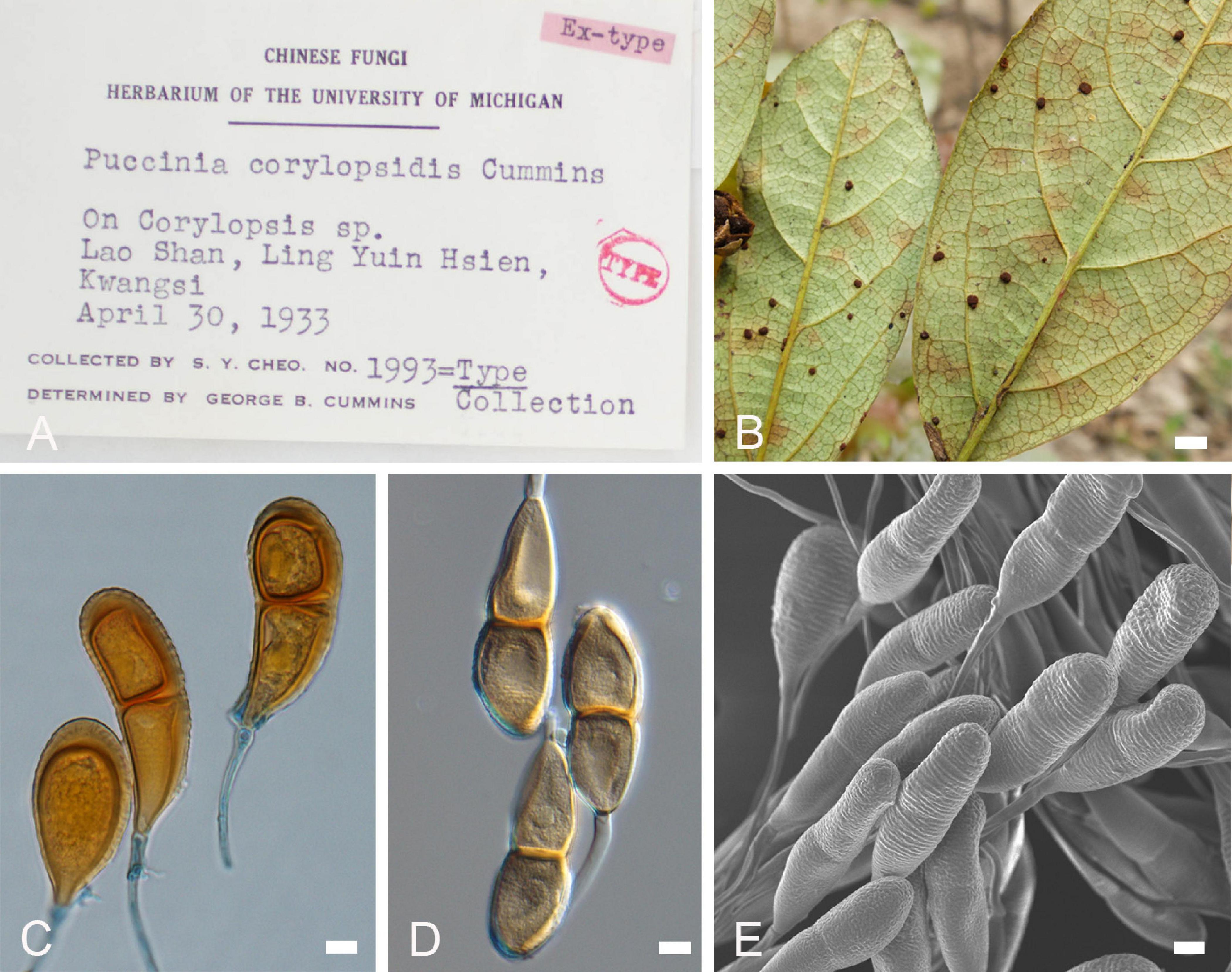
Figure 5. Morphology of Novopuccinia corylopsidis (BJFC-R02977, B–E). (A) Information of type specimen. (B) Sori on a leaf. (C,D) Teliospores, as seen by LM. (E) Teliospores, as seen by SEM. Scale bars: (A) = 1 mm; (B,E) = 10 μm.
MycoBank MB 838358
Basionym: Puccinia corylopsidis Cummins, Mycologia 43(1): 83 (1951)
Descriptions: Spermogonia, aecia, and uredinia unknown. Telia mostly hypophyllous, round, pulvinate, 0.1–0.4 mm in diameter, and blackish brown. Teliospores variable in shape, wall thickness, and surface structure, including two types. One kind was regarded as thin side wall and apex wall slightly thickened or not thickened, 1–2 μm thick, light yellow, oval, 47–65 × 16–20 μm, not or hardly constricted at septum, the wall nearly smooth. The other kind was characterized by the wall apically and unilaterally thickened, 1.5–9 μm thick at sides, up to 18 μm thick at apex, mostly fusoid to oval, 46–82 × 16–29 μm, not or hardly constricted at septum, the wall rugose or densely covered with irregular verrucous wrinkles, and yellowish to brown; the pedicel hyaline, thick-walled, persistent, and up to 150 μm. One-celled spores rarely seen. All these variant spores are produced in the same sorus.
Habitat and distribution: On Sycopsis sinensis and Corylopsis sp. in China (Cummins, 1951; Zhuang et al., 2003).
Specimens examined: China. Lao Shan et al., 1931, April 30, on Corylopsis sp. (type: BPI 058871); Sanqingshan, Jiangxi Province, 28°53′95″N, 118°04′52″E, 1,342 m alt. (BJFC-R02977) and 28°53′88″N, 118°04′57″, 1,340 m alt. (BJFC-R02978), April 1, 2017, on Sycopsis sinensis Oliv., coll. Y.M. Liang.
Notes: The species was first reported on Corylopsis plants and named P. corylopsidis based on Puccinia-like teliospores (Cummins, 1951). However, it differs from other Puccinia species by dimorphic teliospores (Figure 5). Our molecular phylogenetic analysis indicated that P. corylopsidis closely related to Novopuccinia, with strong support (Figures 2, 3), hence the new combination in the new genus. Sycopsis sinensis is the new host found for N. corylopsidis in this study.
Novopuccinia hamamelidis (Dietel) Y. Liu & Y. M. Liang, comb. nov. Figure 6
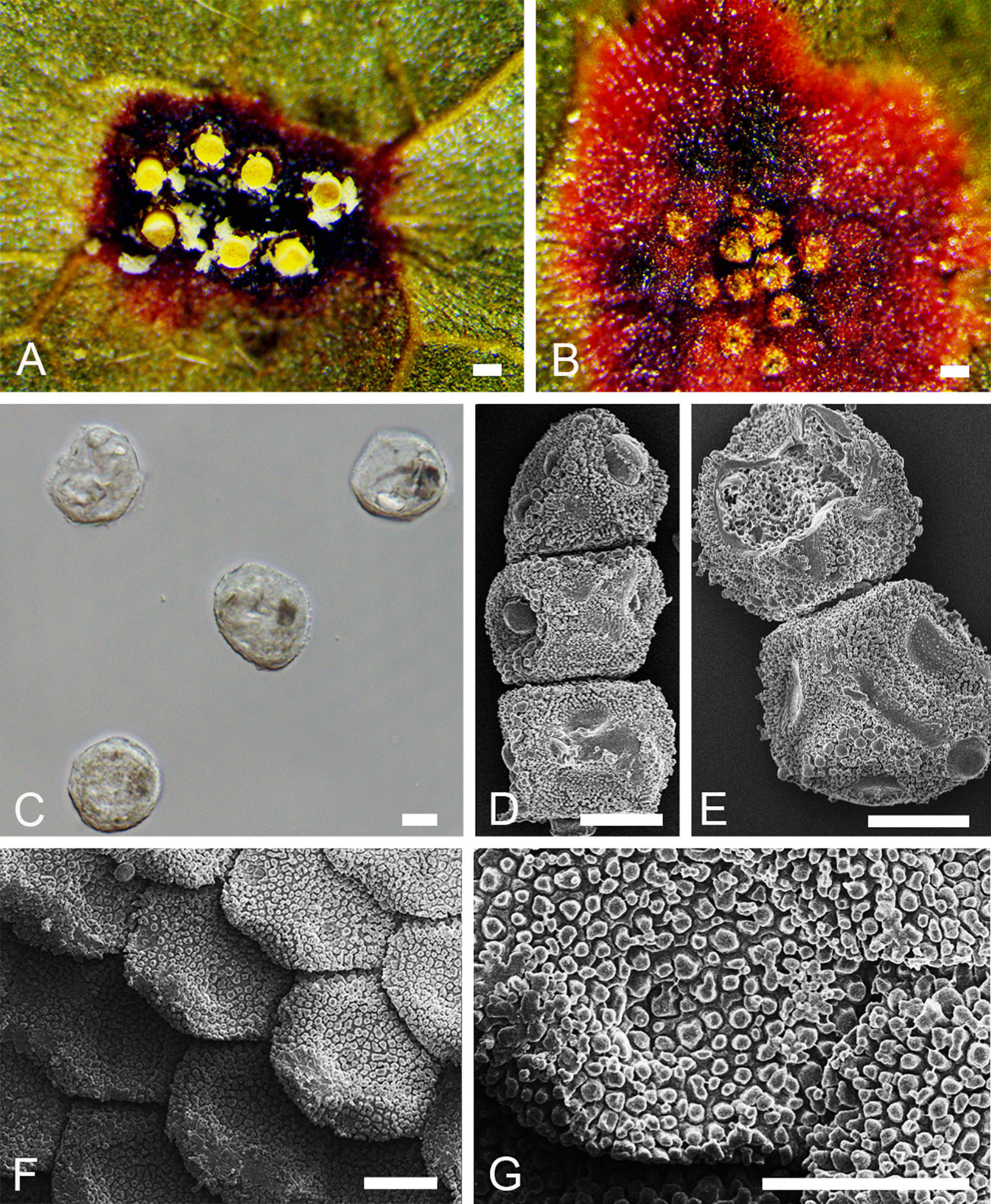
Figure 6. Morphology of Novopuccinia hamamelidis BJFC-R3798 (IBAR6666). (A) Aecia on a leaf. (B) Spermogonia on a leaf. (C) Aeciospores, as seen by LM. (D,E) Aeciospores, as seen by SEM. (F,G) Peridial cells, as seen by SEM. Scale bars: (A,B) = 100 mm; (C,G) = 10 μm.
MycoBank MB 838359
Basionym: Aecidium hamamelidis Dietel (1899), Bot. Jb. 27: 571
Synonyms: Puccinia mitriformis Ito (1909), J. Coll. Agric. Tohaku Imper. Univ. 3(2): 233
Aecidium hamamelidis Magnus (1901), Ber. Dt. Bot. Ges. 19: 297
Descriptions: Spermogonia and aecia occur on species of Hamamelis; spermogonia abaxial, round, 140 μm in diameter. Aecia hypophyllous, cup shape, the cross-section diameter is about 140–150 μm. Aeciospores obovoid or globose, 20–32 × 28–30 μm, surface is covered with irregular verrucosa. Peridial cells round, 30 μm in diameter, outer walls smooth, inner walls moderately rugose with regular papillae. Telia on abaxial surface of Sasa plants, early exposed, chocolate-brown; teliospores 95–130 × 18–22 μm, walls usually unilaterally thickened, 2–3 μm on the thin side, somewhat to much thicker on opposite side, 40–70 μm apically, golden brown but the apical thickening much paler, smooth, or perhaps minutely rugose on the broad part of the spore; pedicels mostly not collapsing, colorless, long and tapering, 250 μm long; one-celled spores rare (For telia stage, cited from Hiratsuka et al., 1992).
Habitat and distribution: On Hamamelis japonica (spermogonial/aecial stages) and Sasamorpha spp. (uredinial/telial stages) in Japan.
Specimens examined: JAPAN. Ibaraki et al. (1992), August 10, on Hamamelis japonica Siebold and Zucc (1992) and Higuchi et al. (1998) (epitype: BJFC-R3798 = IBAR-6666) and June 28, (BJFC-R3807 = IBAR-6615); June 7, on Hamamelis japonica Siebold & Zucc., coll. Y. Ono & K. Ishimiya (BJFC-R3799 = BAR-8075); Ibaraki et al. (1994), May 13, on Hamamelis japonica Siebold & Zucc., coll. Y. Ono (BJFC-R3800 = IBAR-7170); August 13, 1992, on Hamamelis japonica Siebold & Zucc., coll. K. Higuchi, K. Suganuma, and K. Hashimoto (BJFC-R3801 = IBAR-6553); Aomori, Mt. Hakkodasan, July 31, 1992, on Hamamelis japonica Siebold & Zucc., Isono (1973) (BJFC-R3802 = IBAR-5567); Gumma, Tone-gun, June 18, on Hamamelis japonica Siebold & Zucc., coll. Y. Ono (BJFC-R3803 = IBAR-1585); Tochigi et al. (1992), July 15, on Hamamelis japonica Siebold & Zucc., coll. Y. Ono (BJFC-R3804 = IBAR-2194); Ibaraki et al. (1989), July 27, on Hamamelis japonica Siebold & Zucc., coll. Y. Ono & H. Miura (BJFC-R3805 = IBAR-3291); Tochigi et al. (1990), August 26, on Hamamelis japonica Siebold & Zucc., coll. M. Sawamura and N. Matsumoto (BJFC-R3806 = IBAR-5475).
Notes: Dietel (1899) described this fungus as Aecidium hamamelidis based on the Aecidium-type Aecia on Hamamelis plants. It is also related to the bamboo rust P. mitriformis S. Ito reported by Hiratsuka and Sato (1970). We did not observe the type specimen of A. hamamelidis, but specimens that were collected from the same region and host with type collection were researched. For further study, here we designate BJFC-R3798 as the epitype specimen. Our molecular phylogenetic analysis recovered A. hamamelidis within the new genus, with strong support (Figures 2, 3), hence the new combination in Novopuccinia.
Discussion
In this study, three rust taxa obtained from Hamamelidaceae were identified based on morphologic characters and phylogeny based on the 28S and 5.8S-ITS2 sequences. As a result, Novopuccinia typified with N. sycopsis-sinensis is proposed as a new genus in Pucciniaceae. The two known species, P. corylopsidis and Aecidium hamamelidis, were combined to the new genus (N. corylopsidis and N. hamamelidis) by the same host plant, the molecular data, and endocyclic life cycle.
Novopuccinia includes two different teliospore types. The first type is represented by type species N. sycopsis-sinensis with one-celled teliospores and belongs to the kind of taxa, whose telia are cupulate, usually with peridia, and teliospores are verrucose and catenulate with intercalary cells. These taxa are considered to have been derived from a Puccinia–Uromyces complex by reduction of the life cycle through the endophylloid pathway; their occurrence on the same host plants may nonetheless provide clues on the relationship between microcyclic and long-cycled autoecious rust fungi (Jackson, 1931; Buriticá and Hennen, 1980). Members of this complex are closely related to the environment and occur mainly in tropical and other warm regions (Berndt, 2018). The second type is similar to Puccinia-like teliospores and represented by P. corylopsidis and Aecidium hamamelidis (synonym: Puccinia mitriformis), but phylogenetically closely related to Novopuccinia sycopsis-sinensis (Figures 2, 3). While teliospore characters are deemed important to distinguishing genera and families within Pucciniales (Cummins and Hiratsuka, 2003), molecular phylogenies show that their morphological characteristics may not always define higher taxa (Aime, 2006; Beenken and Wood, 2015). Consequently, several genera have diverged from the genus Puccinia sensu lato, despite their similarity in two-celled teliospore morphology such as Allodus (Minnis et al., 2012), Austropuccinia (Beenken, 2017), and Puccorchidium (Beenken and Wood, 2015). However, genera that have been separated from Puccinia based on differences in their morphology appear within Puccinia, such as Uromyces, Diorchidium, Cumminsiella, and Miyagia (Figures 2, 3; Aime, 2006; Van Der Merwe et al., 2008; Beenken and Wood, 2015). New combined species, Novopuccinia corylopsidis and N. hamamelidis, were defined by combining their distant relationship to type species of Puccinia clade, their close relationship with type species N. sycopsis-sinensis (Figures 2, 3), common hosts, and evolution hypothesis of the endocyclic life cycle.
The new genus is sister to Stereostratum (Figure 3), but they differ in teliospore characters. Novopuccinia contains two teliospore types (Figures 4, 5), while Stereostratum has one kind of teliospore (Mangus, 1898). Teliospores of N. corylopsidis and N. hamamelidis are thick-walled and have one germ pore in each cell (Figure 5; Hiratsuka and Sato, 1970; Hiratsuka et al., 1992), while Stereostratum spp. have three germ pores in each teliospore cell, and their wall does not thicken (Mangus, 1898).
The type species of Novopuccinia, namely, N. sycopsis-sinensis, is microcyclic in the life cycle and produces catenulate, rough-surfaced teliospores with intercalary cells between them. The similar life cycle pattern and morphological characteristics and close phylogenetic relationship to N. corylopsidis and N. hamamelidis (Figures 2, 3) indicate that N. sycopsis-sinensis was derived from a hypothetical puccinioid ancestor by reduction of the life cycle through the endophylloid pathway (Jackson, 1931; Buriticá and Hennen, 1980). In this pathway, morphologically Aecidium-type telia of a derived microcyclic species are produced on a spermogonial/aecial host plant of a putative ancestral macrocyclic heteroecious species. Similarly, N. corylopsidis might have been derived from the same hypothetical ancestor by reduction of the life cycle through the telioid pathway (Jackson, 1931; Buriticá and Hennen, 1980). The latter evolutionary pathway is well-known and is accounted for by Tranzschel’s Law (Shattock and Preece, 2000). These two evolutionary phenomena and resulting correlations between macrocyclic heteroecious species and microcyclic species have been corroborated to a slight extent by a molecular phylogenetic method. Early successful studies include graminicolous puccinias (Zambino and Szabo, 1993), macrocyclic heteroecious Cronarium and endocyclic Peridermium (Vogler and Bruns, 1998), the P. monoica species complex (parasitizing on Brassicaceae and Poaceae) (Roy et al., 1998), and the P. hemerocallidis species complex (parasitizing Caprifoliaceae and Xanthorrhoeaceae) (Chatasiri et al., 2006).
Sycopsis sinensis (Hamamelidaceae) has been listed as a protected species in China based on its ecological value and rarity (Zang and Bian, 2003; Xu et al., 2007). No disease has been reported in this species to date. Two distinct rust fungi on two adjacent S. sinensis trees, N. sycopsis-sinensis and N. corylopsidis, were found in the present study. N. corylopsidis has earlier been reported on Corylopsis sp. (Cummins, 1951), and now we observe host expansion and parasitism involving S. sinensis. At the same time, we suspect that the species had mutated to adapt to the environment, thus forming a new rust N. sycopsis-sinensis that also causes disease.
In addition to these three species, two more species have been reported on Hamamelidaceae in Japan, namely, P. sasicola (Hara) Hino & Katumoto on C. glabrescens (spermogonial/aecial stages) and Sasamorpha borealis (telial stage), P. sakamotoi Hirats. f. & Yoshin on Distylium spp. (Hiratsuka, 1942; Hino and Katumoto, 1955). The former is heteroecious and demicyclic; its teliospores are thick-walled, similar to those of N. corylopsidis and N. hamamelidis (Hino and Katumoto, 1955; Hiratsuka et al., 1992). However, it differs from the latter two species by its demicyclic life cycle and hosts during telia stage. The latter is demicyclic and autoecious on Distylium, cylindrical telia are similar to N. sycopsis-sinensis (Figure 4), and two-celled teliospores with thick walls are similar to N. corylopsidis and N. hamamelidis (Figure 5; Hiratsuka et al., 1992). However, teliospores of the latter are one-celled with elongated pedicel-like intercalary cells, while P. sakamotoi produces two-celled teliospores without intercalary cells (Hiratsuka, 1942). An autoecious and demicyclic life cycle can also distinguish it from similar species. No molecular data have been used to analyze the relationship between these two species and Novopuccinia on Hamamelidaceae, although we may assume that they are closely related to N. corylopsidis and N. hamamelidis based on the observation of similar teliospores, hosts of spermogonial/aecial stages, and distribution. Further investigations will confirm this conjecture.
Key to Rust Fungal Species That Were Recorded on the Host Family Hamamelidaceae in Asia
1. Life cycle macrocyclic, heteroecious …………………………………… 2
1. Life cycle microcyclic or demicyclic and autoecious …………… 3
2. Teliospores two-celled, pedicellate, wall apically prominently elongated; spermogonial and aecial stages on Corylopsis (Trib. Corylopsideae); distributed in Japan …………………………………………………….. Puccinia sasicola
2. Teliospores two-celled, pedicellate, wall mostly unilaterally thickened; spermogonial and aecial stages on Hamamelis (Trib. Hamamelideae); distributed in Japan …………………………………….. Novopuccinia hamamelidis
3. Telia columnar; teliospore one-celled, catenulate; only telia produced on Sycopsis (Trib. Fothergilleae); distributed in China ……………………………………. Novopuccinia sycopsis-sinensis
3. Telia pulvinate …………………………………………………………………… 4
4. Teliospores two-celled, pedicellate, wall mostly unilaterally thickened; only telia produced on Corylopsis (Trib. Corylopsideae) and Sycopsis (Trib. Distylteae); distributed in China …………………………………………… Novopuccinia corylopsidis
4. Teliospores two-celled, pedicellate, wall evenly thickened at sides; aecia and telia produced on Distylium (Trib. Fothergilleae); distributed in Japan ………………………. Puccinia sakamotoi
Data Availability Statement
The datasets presented in this study can be found in online repositories. The names of the repository/repositories and accession number(s) can be found below: https://www.ncbi.nlm.nih.gov/genbank/ MN943642, MN943643, MW136693, MW136697, MW386782, MW386783, MW394517.
Author Contributions
YLa and CT conceived and designed the experiments. YLu, BC, and WL performed the experiments. YLu and YO analyzed the data. YLu wrote the manuscript. YO and YLa revised and approved the final version of the manuscript. All authors contributed extensively to the work presented in this manuscript.
Funding
The National Natural Science Foundation Program of China (No. 31870628) supported this study.
Conflict of Interest
The authors declare that the research was conducted in the absence of any commercial or financial relationships that could be construed as a potential conflict of interest.
The reviewer PZ declared a shared affiliation with one of the authors BC to the handling editor at the time of review.
Acknowledgments
We thank Prof. M. Kakishima, University of Tsukuba, Tsukuba, Japan, for providing comments relating to this report. We express our gratitude to Dr. Lisa A. Castlebury (USDA ARS Mycology and Nematology Genetic Diversity and Biology Laboratory, Baltimore, United States) for providing us with photomicrographs of Puccinia corylopsidis for use in this study.
Supplementary Material
The Supplementary Material for this article can be found online at: https://www.frontiersin.org/articles/10.3389/fmicb.2021.648890/full#supplementary-material
Footnotes
- ^ http://www.indexfungorum.org
- ^ http://www.efloras.org/
- ^ http://mafft.cbrc.jp/alignment/server/
- ^ www.treebase.org
References
Aime, M. C. (2006). Toward resolving family-level relationships in rust fungi (Uredinales). Mycoscience 47, 112–122. doi: 10.1007/s10267-006-0281-0
Aime, M. C., and Mctaggart, A. (2020). A higher-rank classification for rust fungi, with notes on genera. Fungal Syst. Evol. 7, 21–47. doi: 10.3114/fuse.2021.07.02
Beenken, L. (2017). Austropuccinia: a new genus name for the myrtle rust Puccinia psidii placed within the redefined family Sphaerophragmiaceae (Pucciniales). Phytotaxa 297, 53–61. doi: 10.11646/phytotaxa.297.1.5
Beenken, L., and Wood, A. R. (2015). Puccorchidium and Sphenorchidium, two new genera of Pucciniales on Annonaceae related to Pucciniapsidii and the genus Dasyspora. Mycol. Prog. 14, 1–13. doi: 10.1007/s11557-015-1073-8
Beenken, L., Zoller, S., and Berndt, R. (2012). Rust fungi on Annonaceae II: the genus Dasyspora Berk. & M.A. Curtis. Mycologia 104, 659–681. doi: 10.3852/11-068
Berndt, R. (2018). The Pucciniosiraceae: taxonomy of a polyphyletic family of the rust fungi (Uredinales). Biosyst. Ecol. Ser. 34, 245–269.
Buriticá, P., and Hennen, J. F. (1980). Pucciniosireae (Uredinales, Pucciniaceae). Flora Neotrópica, 24. New York, NY: New York Botanical Garden.
Buriticá, P. C. (1991). Familias del orden Uredinales con ciclo de vida completamente reducido. Revta Acad Colomb Cienc Exact Fís Nat. 18, 131–148.
Chatasiri, S., Kitade, O., and Ono, Y. (2006). Phylogenetic relationships among Puccinia hemerocallidis, P. funkiae, and P. patriniae (Uredinales) inferred from ITS sequence data. Mycoscience 47, 123–129. doi: 10.1007/S10267-006-0283-Y
Cummins, G. B. (1951). Uredinales from continental China collected by S.Y. Cheo. II. Mycologia 43, 78–98. doi: 10.2307/3755549
Cummins, G. B., and Hiratsuka, Y. (2003). Illustrated Genera Of Rust Fungi III. Saint Paul, MN: American Phytopathological Society.
Darriba, D., Taboada, G. L., Doallo, R., and Posada, D. (2012). jModelTest 2: more models, new heuristics and parallel computing. Nat. Methods 9:772. doi: 10.1038/nmeth.2109
Hara, K. (1939). On the life-history of Puccinia sasaecola Hara on Sasamorpha purpurescens Nakai. Bot. Zool. 7, 1618–1620.
Hara, K. (1952). Inoculation experiments with Puccinia sasaecola Hara. Ann. Phytopathol. Soc. Jpn. 16:71. doi: 10.3186/jjphytopath.16.71
Hino, I., and Katumoto, K. (1955). Illustrationes fungorum bambusicolorum III. Bull. Fac. Agr. Yamaguti Univ. 6, 29–68.
Hiratsuka, N. (1942). Notae Uredinologiae Asiae Orientalis. I. Bot. Mag. 1, 374–382. doi: 10.15281/jplantres1887.56.374
Hiratsuka, N., and Sato, S. (1970). Notes on Puccinia mitriformis S. Ito. Reps. Tottori Mycol. Inst. 8, 39–44.
Hiratsuka, N., Sato, S., Katsuya, K., Kakishima, M., Hiratsuka, Y., Kaneko, S., et al. (1992). The Rust Flora of Japan. Tsukuba: Tsukuba Shuppankai.
Ito, K. (1909). On the Uredinales parasitic on the Japanese Gramineae. J. Coll. Agr. Tohoku Imp. Univ. 3, 180–265.
Jackson, H. S. (1931). Present evolutionary tendencies and the origin of life cycles in the Uredinales. Mem. Torrey Bot. Club 18, 5–108.
Katoh, K., and Standley, D. M. (2013). MAFFT multiple sequence alignment software version 7: improvements in performance and usability. Mol. Biol. Evol. 30, 772–780. doi: 10.1093/molbev/mst010
Kern, F. D. (1939). Chardoniella—a new genus of the Uredinales. Mycologia 31, 373–375. doi: 10.1080/00275514.1939.12017352
Lagerheim, G. (1891). Pucciniosira, Chrysopsora, Alveolaria und Trichopsora, vier neue Uredineen-Gattungen mit tremelloider Entwickelung. Ber. Deutsch. Bot. Ges. 9, 344–348.
Liu, Y., Cao, B., Tao, S. Q., Tian, C. M., and Liang, Y. M. (2018). Phragmidium species parasitizing species of Rosaceae inTibet, China, with descriptions of three new species. Mycol. Prog. 17, 967–988. doi: 10.1007/s11557-018-1406-5
Magnus, P. (1901). Ueber einige von J. Bornmüller im Jahre 1900 auf den canarischen Inseln gesammelte Uredineen. Ber. Dtsch. Bot. Ges. 19, 292–300.
Minnis, A. M., McTaggart, A. R., Rossman, A. Y., and Aime, M. C. (2012). Taxonomy of mayapple rust: the genus Allodus resurrected. Mycologia 104, 942–950. doi: 10.3852/11-350
O’Donnell, K. (1993). “Fusarium and its near relatives,” in The fungal Holomorph: Mitotic, Meiotic and Pleomophic Speciation in Fungal Systematics, eds D. R. Reynolds and J. W. Taylor (Wallingford: CABI), 225–233.
Ono, Y. (2017). Rust fungi (Pucciniales) in northern Ibaraki prefecture. Bull. Coll. Educ. Ibaraki Univ (Nat. Sci) 66, 37–56.
Posada, D., and Crandall, K. A. (1998). Modeltest: testing the model of DNA substitution. Bioinformatics 14, 817–818. doi: 10.1093/bioinformatics/14.9.817
Rannala, B., and Yang, Z. (1996). Probability distribution of molecular evolutionary trees: a new method of phylogenetic inference. J. Molec. Evol. 43, 304–311. doi: 10.1007/BF02338839
Ronquist, F., and Huelsenbeck, J. P. (2003). MrBayes 3: bayesian phylogenetic inference under mixed models. Bioinformatics 19, 1572–1574. doi: 10.1093/bioinformatics/btg180
Roy, B. A., Vogler, D. R., Burns, T. D., and Szaro, T. M. (1998). Cryptic species in the Puccinia monoica complex. Mycologia 90, 846–853. doi: 10.2307/3761326
Shattock, R. C., and Preece, T. F. (2000). Tranzschel revisited: modern studies of the relatedness of different rust fungi confirm his law. Mycologist 14, 113–117. doi: 10.1016/S0269-915X(00)80086-5
Swofford, D. L. (2003). PAUP: Phylogenetic Analysis Using Parsimony, and Other Methods, Version 4.0b10. Sunderland, MA, USA: Sinauer Associates.
Tian, C. M., Shang, Y. Z., Zhuang, J. Y., Wang, Q., and Kakishima, M. (2004). Morphological and molecular phylogenetic analysis of Melampsora species on poplars in China. Mycoscience 45, 56–66. doi: 10.1007/S10267-003-0150-Z
Van Der Merwe, M. M., Walker, J., Ericson, L., and Burdon, J. J. (2008). Coevolution with higher taxonomic host groups within the Puccinia / Uromyces rust lineage obscured by host jumps. Mycol. Res. 112, 1387–1408. doi: 10.1016/j.mycres.2008.06.027
Vogler, D. R., and Bruns, T. D. (1998). Phylogenetic relationships among the pine stem rust fungi (Cronartium and Peridermium spp.). Mycologia 90, 244–257. doi: 10.1080/00275514.1998.12026904
Xu, K. Y. (2001). Preliminary Ecology Study on Sycopsis sinensis community in Honhe National Nature Reserve, Hubei Province. Dissertation, Hubei, Central China Normal University.
Xu, S. D., Han, Q. Y., Li, D. X., Guo, Y. D., Li, G., and Li, P. (2007). A large area of Sycopsis sinensis communities were found in the Dalaoling nature reserve of the three gorges. Hubei Forestry Sci. Technol. 4, 61–68.
Zambino, P. J., and Szabo, L. J. (1993). Phylogenetic relationships of selected cereal and grass rusts based on rDNA sequence analysis. Mycologia 85, 401–414. doi: 10.2307/3760702
Zang, M., and Bian, X. M. (2003). A study on the rare and threatened plants in Mt. Sanqingshan, Jiangxi Province. J. Wuhan Bot. Res. 21, 515–520.
Keywords: Pucciniales, Puccinia, life cycle, new species and genus, evolution, Asia
Citation: Liu Y, Cao B, Tian C, Ono Y, Lin W and Liang Y (2021) Taxonomy and Phylogeny of Rust Fungi on Hamamelidaceae. Front. Microbiol. 12:648890. doi: 10.3389/fmicb.2021.648890
Received: 02 January 2021; Accepted: 11 March 2021;
Published: 28 April 2021.
Edited by:
Jun-Jun Liu, Canadian Forest Service, Natural Resources Canada, CanadaReviewed by:
Ludwig Beenken, Swiss Federal Institute for Forest, Snow and Landscape Research (WSL), SwitzerlandPeng Zhao, Chinese Academy of Sciences, China
Copyright © 2021 Liu, Cao, Tian, Ono, Lin and Liang. This is an open-access article distributed under the terms of the Creative Commons Attribution License (CC BY). The use, distribution or reproduction in other forums is permitted, provided the original author(s) and the copyright owner(s) are credited and that the original publication in this journal is cited, in accordance with accepted academic practice. No use, distribution or reproduction is permitted which does not comply with these terms.
*Correspondence: Yingmei Liang, bGlhbmd5bUBiamZ1LmVkdS5jbg==
 Yun Liu
Yun Liu Bin Cao
Bin Cao Chengming Tian
Chengming Tian Yoshitaka Ono
Yoshitaka Ono Weiwei Lin1
Weiwei Lin1 Yingmei Liang
Yingmei Liang